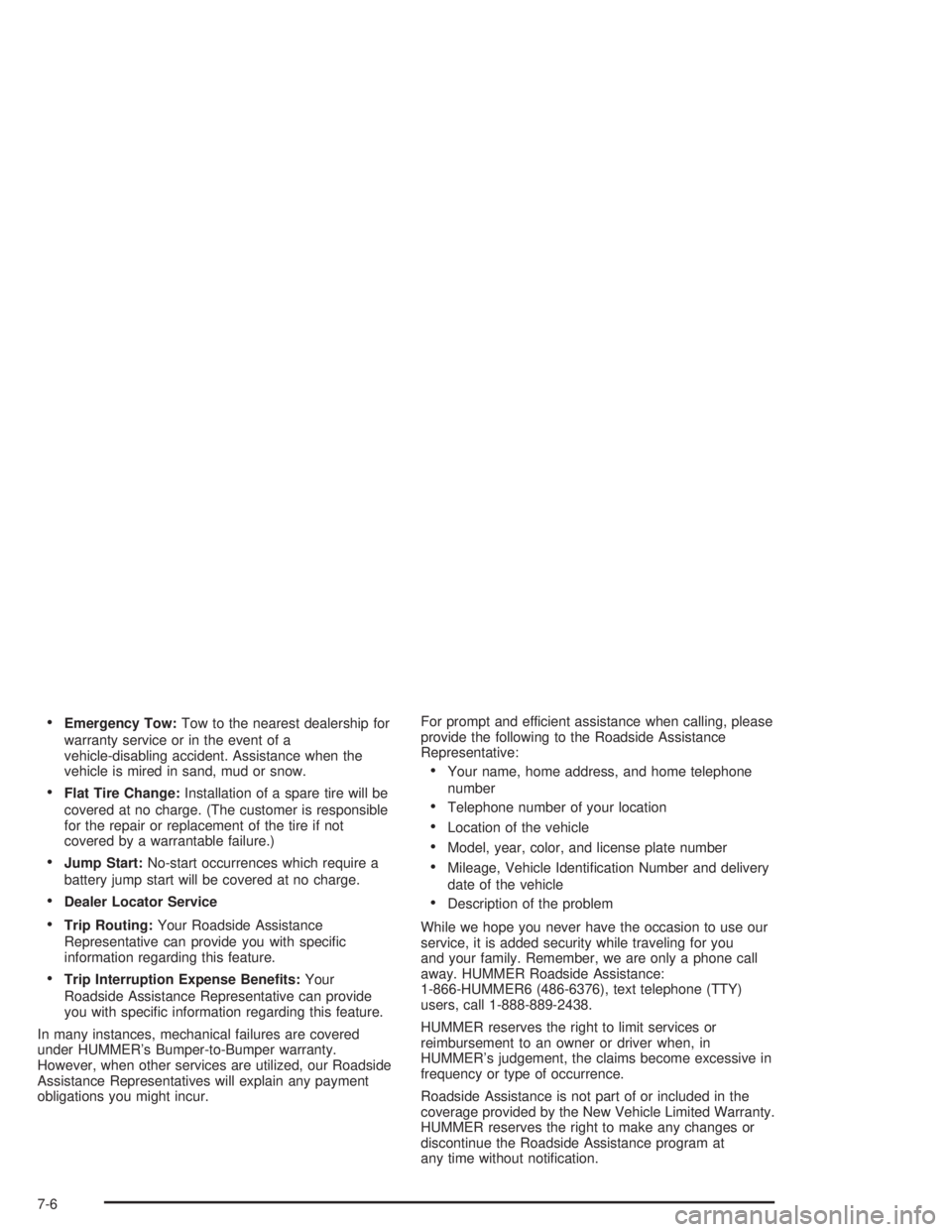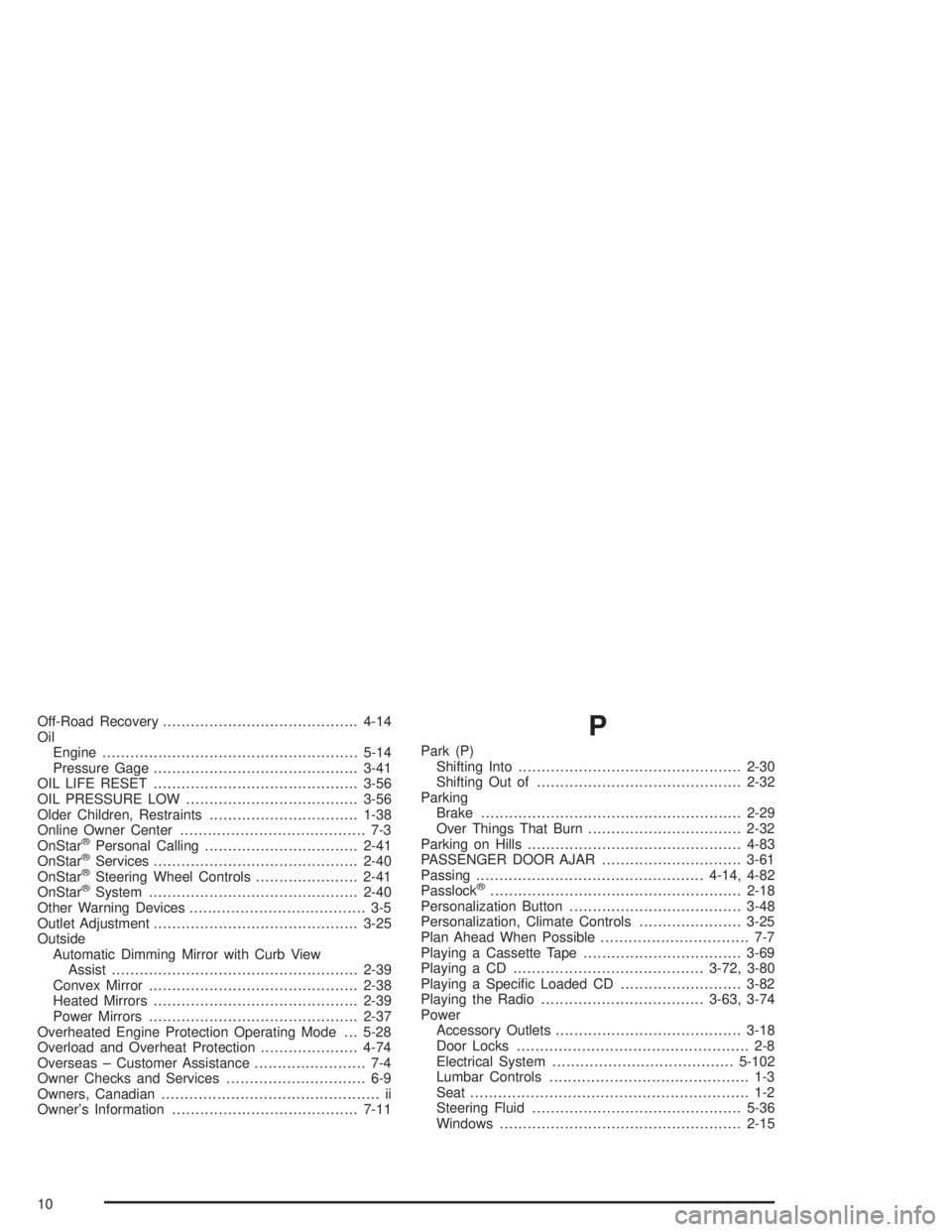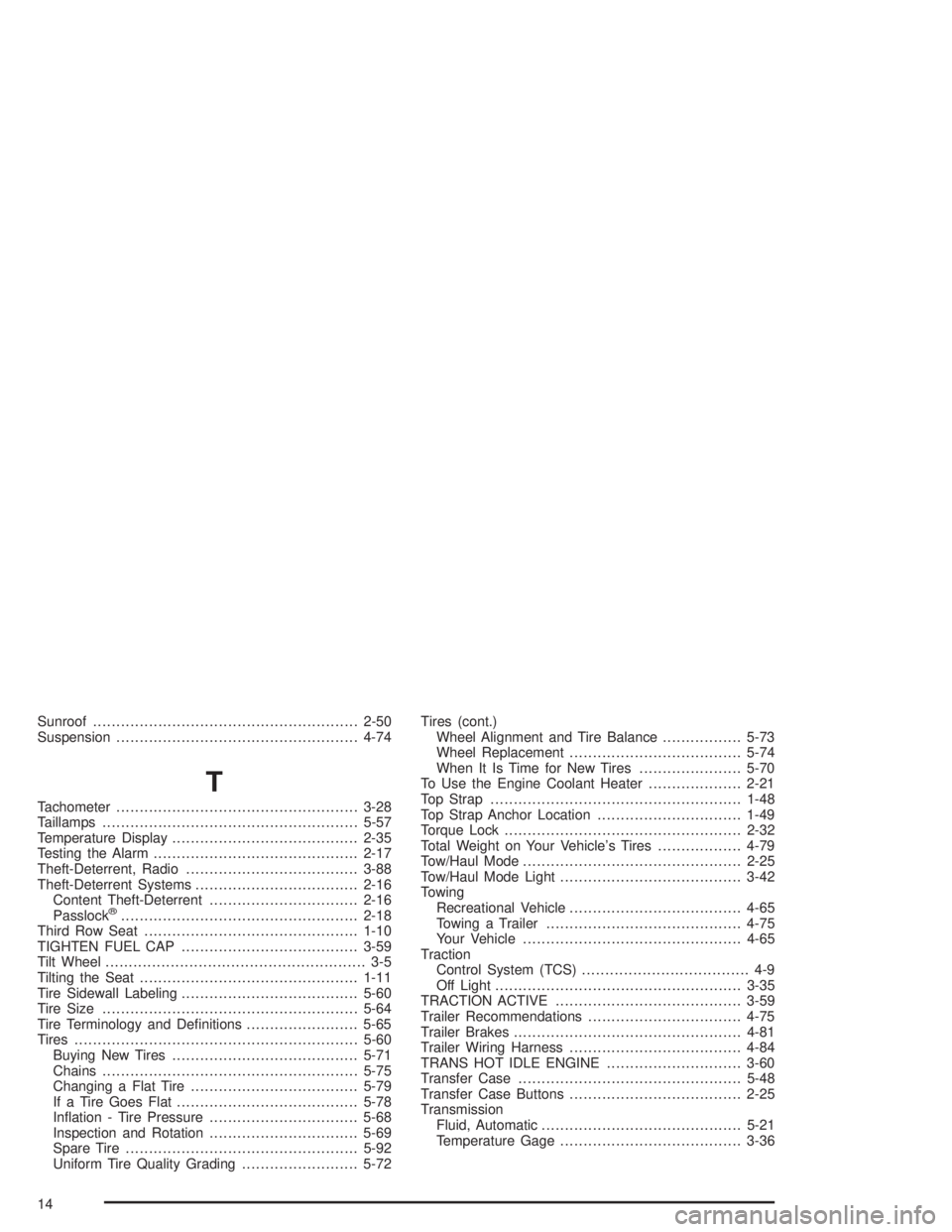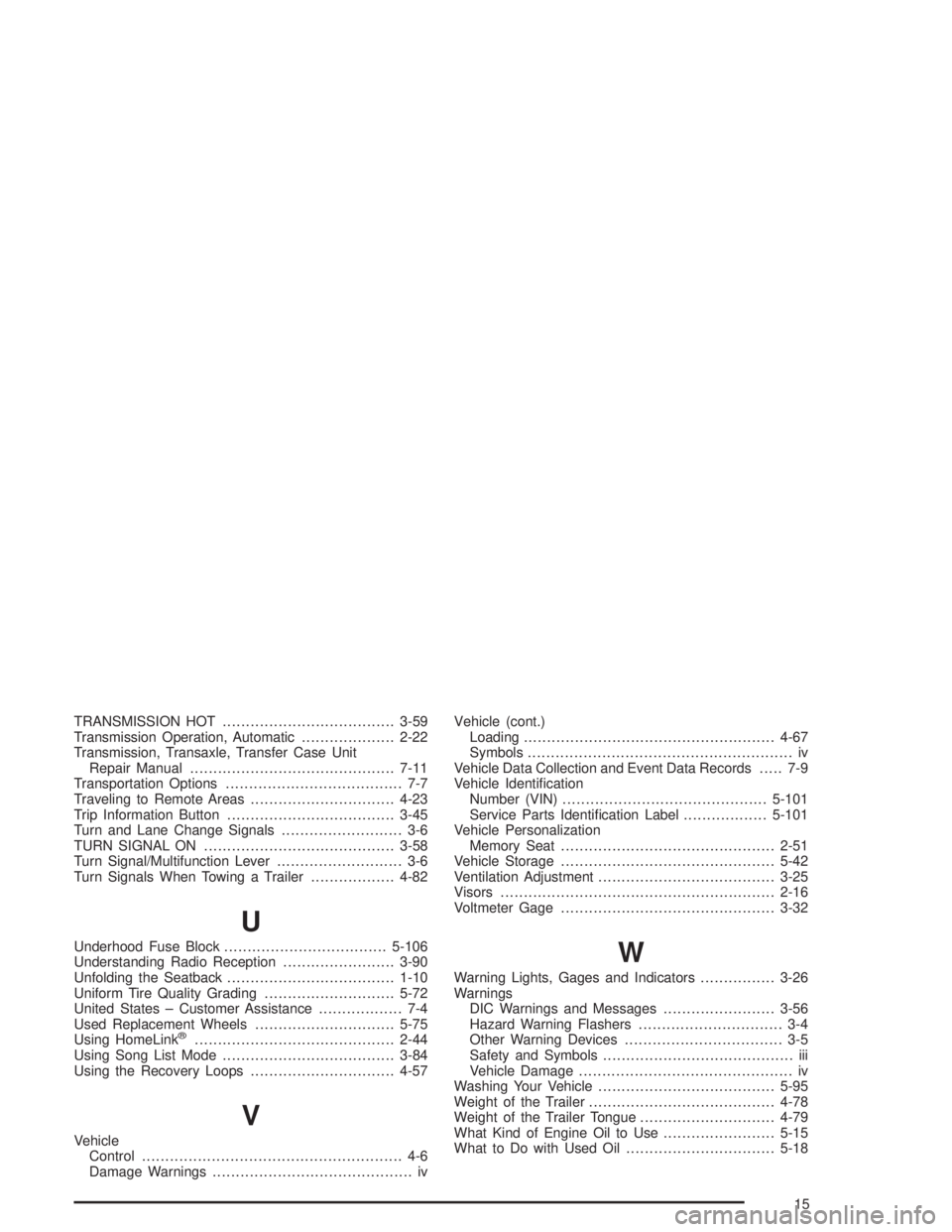ECO mode HUMMER H2 2004 Owner's Manual
[x] Cancel search | Manufacturer: HUMMER, Model Year: 2004, Model line: H2, Model: HUMMER H2 2004Pages: 472, PDF Size: 5.01 MB
Page 300 of 472

Electronically Controlled Air
Suspension System
The electronically controlled air suspension, if equipped,
keeps the rear of your vehicle level as you load and
unload it. The system includes a compressor, two height
sensor and two air springs supporting the vehicle.
The engine must be running for the system to operate
and level the vehicle after loading or unloading. The
system will suspend leveling if any of the doors and/or
the liftgate are open. Once the doors are closed,
system leveling will continue.
You may hear the compressor running when you load
your vehicle, and periodically as the system adjusts
the vehicle to the standard ride height. You may
also hear the release of air similar to a hissing sound
during suspension operation. This is normal.
Load leveling will not function normally with the in�ator
hose attached to the in�ator outlet. Remove the
in�ater hose from the outlet when it is not in use. See
Accessory In�ator on page 5-76.
Overload and Overheat Protection
Overload protection is designed to protect the air
suspension system and is an indication to the driver that
the vehicle is overloaded.
If the rear suspension remains at a low height, the rear
axle load has exceeded GAWR (Gross Axle Weight
Rating). When the overload protection mode is activated,
the compressor operates for about 30 seconds to one
minute without raising the vehicle depending on the
amount of overload. This will continue each time
the ignition is turned on until the rear axle load is
reduced below GAWR.
If the total rear GAWR (Gross Axle Weight Rating) is
reached, the suspension may be slightly less than level.
This is normal and does not mean there is a problem
with the air suspension.
If the system overheats, it will shut down and stop all
leveling functions until the system cools down.
During this time the SERVICE AIR SUSPENSION
message will appear in the DIC. SeeDriver Information
Center (DIC) on page 3-44for more information.
4-74
Page 302 of 472

If yours was built with trailering options, as many are,
it’s ready for heavier trailers. But trailering is different
than just driving your vehicle by itself. Trailering means
changes in handling, accelleration, braking, durability
and fuel economy. Successful, safe trailering takes
correct equipment, and it has to be used properly.
That’s the reason for this part. In it are many time-tested,
important trailering tips and safety rules. Many of
these are important for your safety and that of your
passengers. So please read this section carefully before
you pull a trailer.
If You Do Decide To Pull A Trailer
If you do, here are some important points:
There are many different laws, including speed limit
restrictions, having to do with trailering. Make sure
your rig will be legal, not only where you live
but also where you’ll be driving. A good source for
this information can be state or provincial police.
Consider using a sway control. See “Hitches” later
in this section.
Don’t tow a trailer at all during the �rst 500 miles
(800 km) your new vehicle is driven. Your engine,
axle or other parts could be damaged.
Then, during the �rst 500 miles (800 km) that you
tow a trailer, don’t drive over 50 mph (80 km/h)
and don’t make starts at full throttle. This helps your
engine and other parts of your vehicle wear in at
the heavier loads.
You can tow in DRIVE (D). You may want to shift
the transmission to THIRD (3) or, if necessary, a
lower gear selection if the transmission shifts
too often (e.g., under heavy loads and/or hilly
conditions). See “Tow/Haul Mode” following.
Three important considerations have to do with weight:
the weight of the trailer,
the weight of the trailer tongue
and the weight on your vehicle’s tires.
4-76
Page 303 of 472

Tow/Haul Mode
Tow/haul is designed to assist while your vehicle is
pulling a large or heavy load or trailer. Tow/haul is most
useful while pulling such a load in rolling terrain, in
stop-and-go traffic, or when you need improved
low-speed control, such as when parking. The purpose
of the tow/haul mode is to do the following:
Reduce the frequency and improve the predictability
of transmission shifts when pulling a heavy trailer or
a large or heavy load.
Provide the same solid shift feel when pulling a
heavy trailer or a large or heavy load as when
the vehicle is unloaded.
Improve control of vehicle speed while requiring
less throttle pedal activity when pulling a heavy
trailer or a large or heavy load.
Tow/haul is designed to be most effective when the
vehicle and trailer combined weight is at least 75% of the
vehicle’s Gross Combination Weight Rating (GCWR).
See “Weight of the Trailer” later in this section.Press the button on the
instrument panel to the
right of the steering
wheel to enable the
tow/haul mode.
A light on the instrument
panel will illuminate to
indicate that tow/haul
mode has been selected.
Press the button again to turn off tow/haul. The indicator
light on the instrument panel will turn off. The vehicle will
automatically turn off tow/haul every time it is started.
Driving with tow/haul activated without a heavy load or
with no trailer will cause reduced fuel economy and
unpleasant engine and transmission driving
characteristics, but will not cause damage.
4-77
Page 381 of 472

Maximum Loaded Vehicle Weight:The sum of curb
weight; accessory weight; vehicle capacity weight;
and production options weight.
Normal Occupant Weight:The number of occupants a
vehicle is designed to seat multiplied by 150 pounds
(68 kg). SeeLoading Your Vehicle on page 4-67.
Occupant Distribution:Designated seating positions.
Outward Facing Sidewall:The side of a asymmetrical
tire that has a particular side that faces outward
when mounted on a vehicle. The side of the tire that
contains a whitewall, bears white lettering or bears
manufacturer, brand and or model name molding that is
higher or deeper than the same moldings on the
other sidewall of the tire.
Passenger (P-Metric) Tire:A tire used on passenger
cars and some light duty trucks and multipurpose
vehicles.
Recommended In�ation Pressure:Vehicle
manufacturer’s recommended tire in�ation pressure and
shown on the tire placard. SeeIn�ation - Tire Pressure
on page 5-68andLoading Your Vehicle on page 4-67.
Radial Ply tire:A pneumatic tire in which the ply cords
that extend to the beads are laid at 90 degrees to the
centerline of the tread.Rim:A metal support for a tire and upon which the tire
beads are seated.
Sidewall:The portion of a tire between the tread and
the bead.
Speed Rating:An alphanumeric code assigned to a
tire indicating the maximum speed at which a tire
can operate.
Traction:The friction between the tire and the road
surface. The amount of grip provided.
Tread:The portion of a tire that comes into contact
with the road.
Treadwear Indicators:Narrow bands, sometimes
called “wear bars,” that show across the tread of a tire
when only 2/32 inch of tread remains. SeeWhen It
Is Time for New Tires on page 5-70.
UTQGS:Uniform Tire Quality Grading Standards, a tire
information system that provides consumers with
ratings for a tire’s traction, temperature and treadwear.
Ratings are determined by tire manufacturers using
government testing procedures. The ratings are molded
into the sidewall of the tire. SeeUniform Tire Quality
Grading on page 5-72.
5-67
Page 450 of 472

Emergency Tow:Tow to the nearest dealership for
warranty service or in the event of a
vehicle-disabling accident. Assistance when the
vehicle is mired in sand, mud or snow.
Flat Tire Change:Installation of a spare tire will be
covered at no charge. (The customer is responsible
for the repair or replacement of the tire if not
covered by a warrantable failure.)
Jump Start:No-start occurrences which require a
battery jump start will be covered at no charge.
Dealer Locator Service
Trip Routing:Your Roadside Assistance
Representative can provide you with speci�c
information regarding this feature.
Trip Interruption Expense Bene�ts:Your
Roadside Assistance Representative can provide
you with speci�c information regarding this feature.
In many instances, mechanical failures are covered
under HUMMER’s Bumper-to-Bumper warranty.
However, when other services are utilized, our Roadside
Assistance Representatives will explain any payment
obligations you might incur.For prompt and efficient assistance when calling, please
provide the following to the Roadside Assistance
Representative:
Your name, home address, and home telephone
number
Telephone number of your location
Location of the vehicle
Model, year, color, and license plate number
Mileage, Vehicle Identi�cation Number and delivery
date of the vehicle
Description of the problem
While we hope you never have the occasion to use our
service, it is added security while traveling for you
and your family. Remember, we are only a phone call
away. HUMMER Roadside Assistance:
1-866-HUMMER6 (486-6376), text telephone (TTY)
users, call 1-888-889-2438.
HUMMER reserves the right to limit services or
reimbursement to an owner or driver when, in
HUMMER’s judgement, the claims become excessive in
frequency or type of occurrence.
Roadside Assistance is not part of or included in the
coverage provided by the New Vehicle Limited Warranty.
HUMMER reserves the right to make any changes or
discontinue the Roadside Assistance program at
any time without noti�cation.
7-6
Page 453 of 472

Vehicle Data Collection and Event
Data Records
Your vehicle, like other modern motor vehicles, has a
number of sophisticated computer systems that monitor
and control several aspects of the vehicle’s
performance. Your vehicle uses on-board vehicle
computers to monitor emission control components to
optimize fuel economy, to monitor conditions for air bag
deployment and, if so equipped, to provide anti-lock
braking and to help the driver control the vehicle
in difficult driving situations. Some information may be
stored during regular operations to facilitate repair
of detected malfunctions; other information is stored only
in a crash or near crash event by computer systems
commonly called event data recorders (EDR).
In a crash or near crash event, computer systems, such
as the Air Bag Sensing and Diagnostic Module (SDM)
in your vehicle may record information about the
condition of the vehicle and how it was operated, such
as engine speed, brake applications, throttle position,
vehicle speed, safety belt usage, air bag readiness, air
bag performance data, and the severity of a collision.
This information has been used to improve vehicle crash
performance and may be used to improve crash
performance of future vehicles and driving safety. Unlike
the data recorders on many airplanes, these on-board
systems do not record sounds, such as conversation of
vehicle occupants.To read this information, special equipment is needed
and access to the vehicle or the SDM is required.
GM will not access information about a crash event or
share it with others other thanwith the consent of the vehicle owner or, if the
vehicle is leased, with the consent of the lessee,
in response to an official request of police or similar
government office,
as part of GM’s defense of litigation through the
discovery process, or
as required by law.
In addition, once GM collects or receives data, GM may
use the data for GM research needs,
make it available for research where appropriate
con�dentiality is to be maintained and need is
shown, or
share summary data which is not tied to a speci�c
vehicle with non-GM organizations for research
purposes.
Others, such as law enforcement, may have access to
the special equipment that can read the information
if they have access to the vehicle or SDM.
If your vehicle is equipped with OnStar
®, please check
the OnStar®subscription service agreement or
manual for information on its operations and data
collection.
7-9
Page 466 of 472

Off-Road Recovery..........................................4-14
Oil
Engine.......................................................5-14
Pressure Gage............................................3-41
OIL LIFE RESET............................................3-56
OIL PRESSURE LOW.....................................3-56
Older Children, Restraints................................1-38
Online Owner Center........................................ 7-3
OnStar
®Personal Calling.................................2-41
OnStar®Services............................................2-40
OnStar®Steering Wheel Controls......................2-41
OnStar®System.............................................2-40
Other Warning Devices...................................... 3-5
Outlet Adjustment............................................3-25
Outside
Automatic Dimming Mirror with Curb View
Assist.....................................................2-39
Convex Mirror.............................................2-38
Heated Mirrors............................................2-39
Power Mirrors.............................................2-37
Overheated Engine Protection Operating Mode . . . 5-28
Overload and Overheat Protection.....................4-74
Overseas – Customer Assistance........................ 7-4
Owner Checks and Services.............................. 6-9
Owners, Canadian............................................... ii
Owner’s Information........................................7-11
P
Park (P)
Shifting Into................................................2-30
Shifting Out of............................................2-32
Parking
Brake........................................................2-29
Over Things That Burn.................................2-32
Parking on Hills..............................................4-83
PASSENGER DOOR AJAR..............................3-61
Passing.................................................4-14, 4-82
Passlock
®......................................................2-18
Personalization Button.....................................3-48
Personalization, Climate Controls......................3-25
Plan Ahead When Possible................................ 7-7
Playing a Cassette Tape..................................3-69
Playing a CD.........................................3-72, 3-80
Playing a Speci�c Loaded CD..........................3-82
Playing the Radio...................................3-63, 3-74
Power
Accessory Outlets........................................3-18
Door Locks.................................................. 2-8
Electrical System.......................................5-102
Lumbar Controls........................................... 1-3
Seat............................................................ 1-2
Steering Fluid.............................................5-36
Windows....................................................2-15
10
Page 470 of 472

Sunroof.........................................................2-50
Suspension....................................................4-74
T
Tachometer....................................................3-28
Taillamps.......................................................5-57
Temperature Display........................................2-35
Testing the Alarm............................................2-17
Theft-Deterrent, Radio.....................................3-88
Theft-Deterrent Systems...................................2-16
Content Theft-Deterrent................................2-16
Passlock
®...................................................2-18
Third Row Seat..............................................1-10
TIGHTEN FUEL CAP......................................3-59
Tilt Wheel........................................................ 3-5
Tilting the Seat...............................................1-11
Tire Sidewall Labeling......................................5-60
Tire Size.......................................................5-64
Tire Terminology and De�nitions........................5-65
Tires.............................................................5-60
Buying New Tires........................................5-71
Chains.......................................................5-75
Changing a Flat Tire....................................5-79
If a Tire Goes Flat.......................................5-78
In�ation - Tire Pressure................................5-68
Inspection and Rotation................................5-69
Spare Tire..................................................5-92
Uniform Tire Quality Grading.........................5-72Tires (cont.)
Wheel Alignment and Tire Balance.................5-73
Wheel Replacement.....................................5-74
When It Is Time for New Tires......................5-70
To Use the Engine Coolant Heater....................2-21
Top Strap......................................................1-48
Top Strap Anchor Location...............................1-49
Torque Lock...................................................2-32
Total Weight on Your Vehicle’s Tires..................4-79
Tow/Haul Mode...............................................2-25
Tow/Haul Mode Light.......................................3-42
Towing
Recreational Vehicle.....................................4-65
Towing a Trailer..........................................4-75
Your Vehicle...............................................4-65
Traction
Control System (TCS).................................... 4-9
Off Light.....................................................3-35
TRACTION ACTIVE........................................3-59
Trailer Recommendations.................................4-75
Trailer Brakes.................................................4-81
Trailer Wiring Harness.....................................4-84
TRANS HOT IDLE ENGINE.............................3-60
Transfer Case................................................5-48
Transfer Case Buttons.....................................2-25
Transmission
Fluid, Automatic...........................................5-21
Temperature Gage.......................................3-36
14
Page 471 of 472

TRANSMISSION HOT.....................................3-59
Transmission Operation, Automatic....................2-22
Transmission, Transaxle, Transfer Case Unit
Repair Manual............................................7-11
Transportation Options...................................... 7-7
Traveling to Remote Areas...............................4-23
Trip Information Button....................................3-45
Turn and Lane Change Signals.......................... 3-6
TURN SIGNAL ON.........................................3-58
Turn Signal/Multifunction Lever........................... 3-6
Turn Signals When Towing a Trailer..................4-82
U
Underhood Fuse Block...................................5-106
Understanding Radio Reception........................3-90
Unfolding the Seatback....................................1-10
Uniform Tire Quality Grading............................5-72
United States – Customer Assistance.................. 7-4
Used Replacement Wheels..............................5-75
Using HomeLink
®...........................................2-44
Using Song List Mode.....................................3-84
Using the Recovery Loops...............................4-57
V
Vehicle
Control........................................................ 4-6
Damage Warnings........................................... ivVehicle (cont.)
Loading......................................................4-67
Symbols......................................................... iv
Vehicle Data Collection and Event Data Records..... 7-9
Vehicle Identi�cation
Number (VIN)............................................5-101
Service Parts Identi�cation Label..................5-101
Vehicle Personalization
Memory Seat..............................................2-51
Vehicle Storage..............................................5-42
Ventilation Adjustment......................................3-25
Visors...........................................................2-16
Voltmeter Gage..............................................3-32
W
Warning Lights, Gages and Indicators................3-26
Warnings
DIC Warnings and Messages........................3-56
Hazard Warning Flashers............................... 3-4
Other Warning Devices.................................. 3-5
Safety and Symbols......................................... iii
Vehicle Damage.............................................. iv
Washing Your Vehicle......................................5-95
Weight of the Trailer........................................4-78
Weight of the Trailer Tongue.............................4-79
What Kind of Engine Oil to Use........................5-15
What to Do with Used Oil................................5-18
15